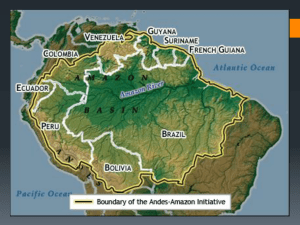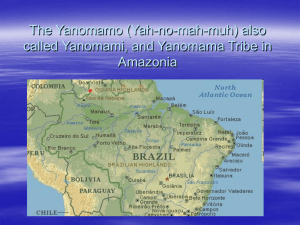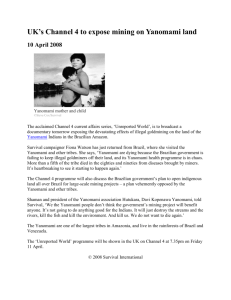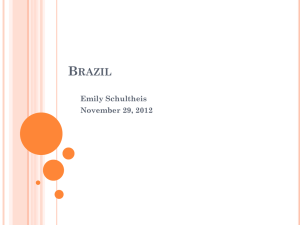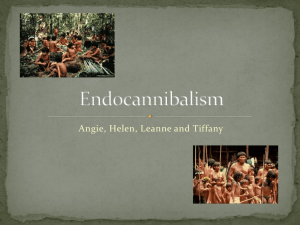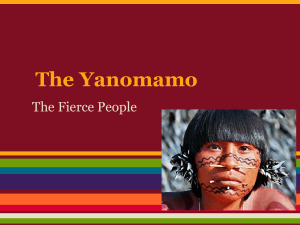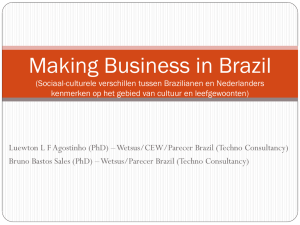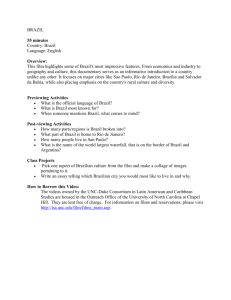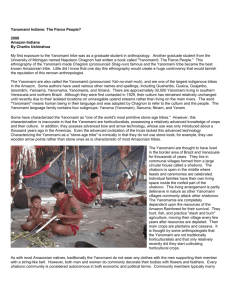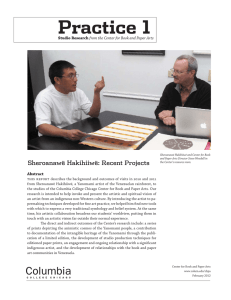A differentiated education for the Yanomami people
advertisement
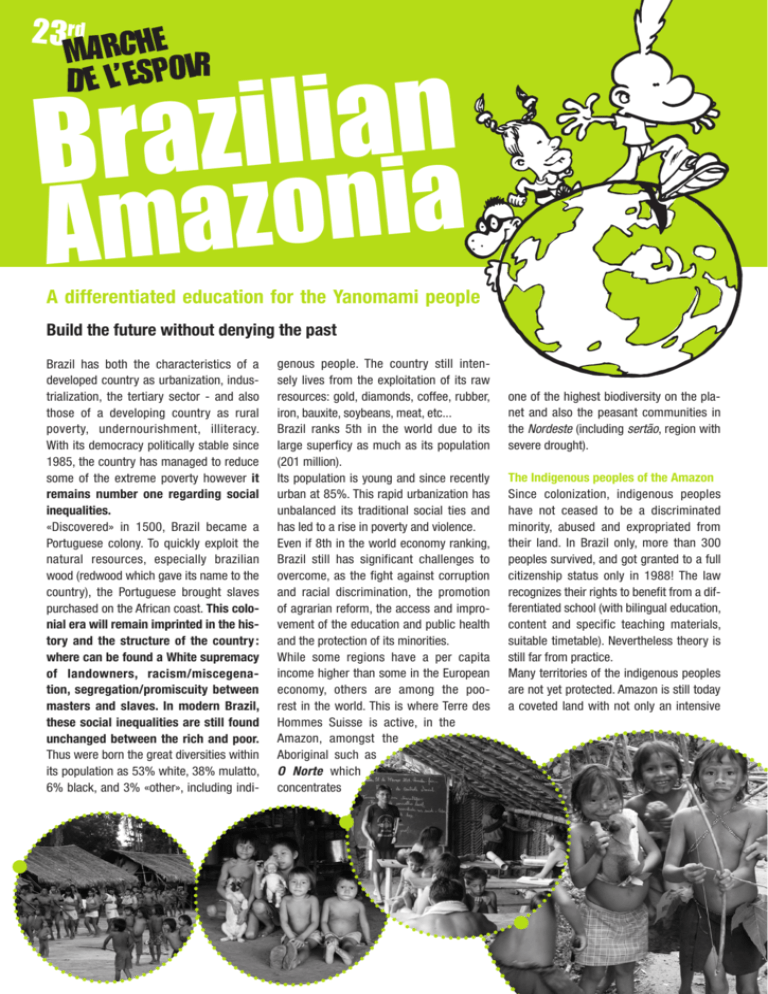
23 rd n a i l i z Bra a i n o z Ama A differentiated education for the Yanomami people Build the future without denying the past Brazil has both the characteristics of a developed country as urbanization, industrialization, the tertiary sector - and also those of a developing country as rural poverty, undernourishment, illiteracy. With its democracy politically stable since 1985, the country has managed to reduce some of the extreme poverty however it remains number one regarding social inequalities. «Discovered» in 1500, Brazil became a Portuguese colony. To quickly exploit the natural resources, especially brazilian wood (redwood which gave its name to the country), the Portuguese brought slaves purchased on the African coast. This colonial era will remain imprinted in the history and the structure of the country : where can be found a White supremacy of landowners, racism/miscegenation, segregation/promiscuity between masters and slaves. In modern Brazil, these social inequalities are still found unchanged between the rich and poor. Thus were born the great diversities within its population as 53% white, 38% mulatto, 6% black, and 3% «other», including indi- genous people. The country still intensely lives from the exploitation of its raw resources: gold, diamonds, coffee, rubber, iron, bauxite, soybeans, meat, etc... Brazil ranks 5th in the world due to its large superficy as much as its population (201 million). Its population is young and since recently urban at 85%. This rapid urbanization has unbalanced its traditional social ties and has led to a rise in poverty and violence. Even if 8th in the world economy ranking, Brazil still has significant challenges to overcome, as the fight against corruption and racial discrimination, the promotion of agrarian reform, the access and improvement of the education and public health and the protection of its minorities. While some regions have a per capita income higher than some in the European economy, others are among the poorest in the world. This is where Terre des Hommes Suisse is active, in the Amazon, amongst the Aboriginal such as O Norte which concentrates one of the highest biodiversity on the planet and also the peasant communities in the Nordeste (including sertão, region with severe drought). The Indigenous peoples of the Amazon Since colonization, indigenous peoples have not ceased to be a discriminated minority, abused and expropriated from their land. In Brazil only, more than 300 peoples survived, and got granted to a full citizenship status only in 1988! The law recognizes their rights to benefit from a differentiated school (with bilingual education, content and specific teaching materials, suitable timetable). Nevertheless theory is still far from practice. Many territories of the indigenous peoples are not yet protected. Amazon is still today a coveted land with not only an intensive exploitation of the forest and its natural resources, but also its farmland and livestock potential, as much as for its mining, and its construction of giant dams. It also creates a huge environmental impact affecting its flora, fauna and peoples whose physical and cultural survival is at risk. The Yanomami (State of Amazonas - Rio Marauiá basins and Demini) The Yanomami area (twice Switzerland), demarcated in 1992, is a mountainous area with rivers as main access roads. Today, the Yanomami live in villages of 50 to 200 people. Following their traditional way of life: semi-nomadic, they make their living from hunting, fishing, picking and seasonal agriculture (bananas, tobacco, cassava and several varieties of tubers). Their houses built of wood and straw are arranged in a circle around a large central square where each family, builds its own domestic space. Few Yanomami speak Portuguese, and even less are aware of the concepts and codes from the napë world (not Yanomami, the outsider). The contact with «White people» mainly brought additional problems: diseases (Influenza, measles, malaria, etc.), malnutrition (natural resources become scarcer and processed products causes dental problems, diabetes, etc..). Secoya, a local partner of Terre des Hommes Suisse, has been fighting for 20 years for the Yanomami rights and develops programs in education and health. «School is important to us, as Yanomami, because we need to learn how to speak, to read and to write Portuguese to write reports, letters and to prepare projects. But the school is also important because it teaches us how to reflect on our culture, our way of life, how to organize our relationship with white people and prepare for our future.» Says Carlito, Yanomami leader. This project goes beyond the hundreds of children, youth and adults in school, this is a real tool for the dignity, survival of the Yanomami people and the defense of its rights. (See also: www.secoya.org.br). Differentiated education: a school in the heart of the forest The school as we know it is a new learning tool in the Yanomami world! The child imitates his parents and those around her, and contributes on her own level to all daily activities of the village. For more than 10 years in 9 xapono is given an appropriate and bilingual teaching by Yanomami teachers trained and supervised by a team of Secoya. Approximately 580 students (including children from 7-year-old to adults) follow a daily teaching of two hours, broken down by level, and not by age. A school, opened to all, allows to keep their livelihoods. Other programs in Brazil In the state of Bahia in the Northeast, Terre des Hommes Suisse also supports rural communities and agricultural schools. In addition to academic subjects, these schools teach cultivation and livestock techniques as well as methods adapted to diversified family farming promoting self-sufficiency. In Norte, Terre des Hommes Suisse also supports the ICR (Indigenous Council of Roraima), a training center for sustainable agriculture for youth coming from about twenty Amerindian groups whose traditional ways of life were swept away by the plundering of their land. Brazil in numbers Capital : Brasília (2.562.963 inhabitants) Cities : 14 cities with more than 1 million inhabitants, São Paulo and Rio have more than 10 million Area : 8,514,876 km2 Population : 201 million (2013) Population under 15 years : 29% Urban population : 85% Currency : Brazilian Real (1 CHF = 2.55 Brazilian Real) Life expectancy : 74 years Adult literacy rate : 90% Net enrollment ratio in primary education : 95% Main exports : Brazil is the first exporter in the world for aluminum, iron, oil, sugar, soy, poultry, beef, unroasted coffee, wood and wood products, etc. Sources : UNICEF, UNDP AMAZONIA Member of Terre des Hommes International Federation and the Geneva Foundation Cooperation ch. Frank-Thomas 31, 1223 Cologny-Genève / T. 022 737 36 28 / F. 022 736 15 10 marchedelespoir@terredeshommessuisse.ch / www.marchedelespoir.ch
